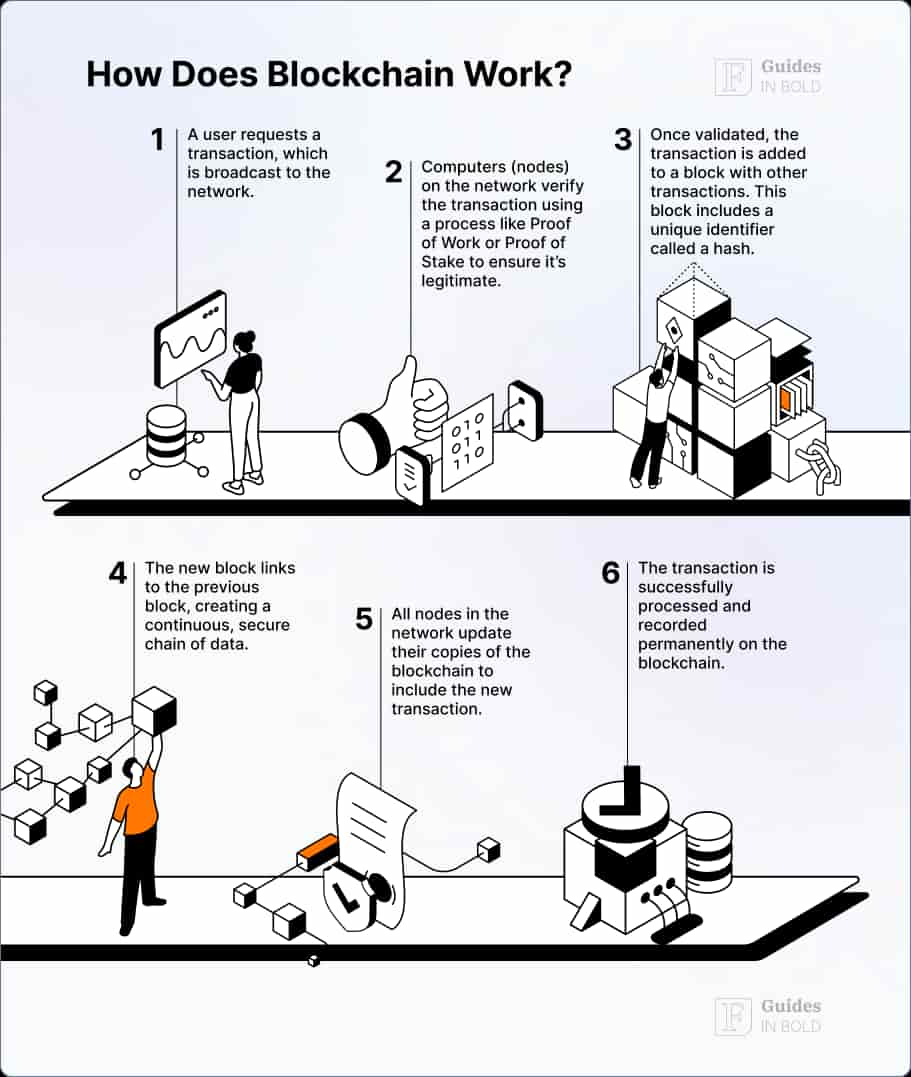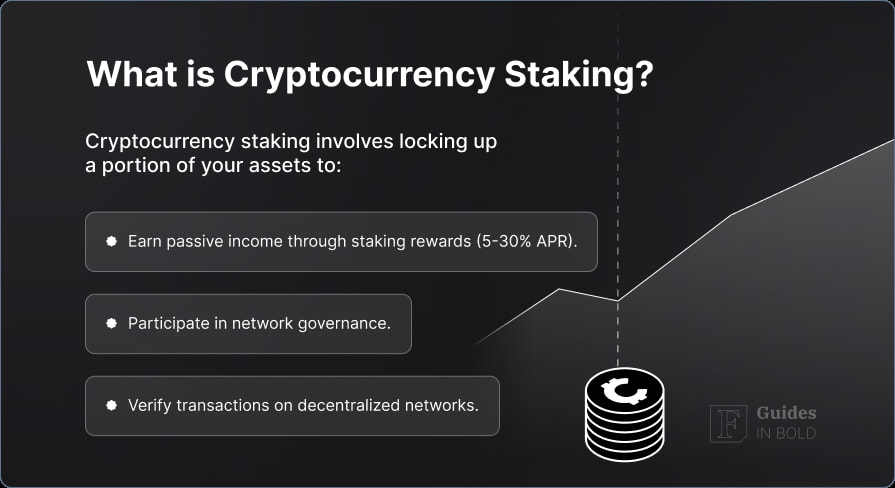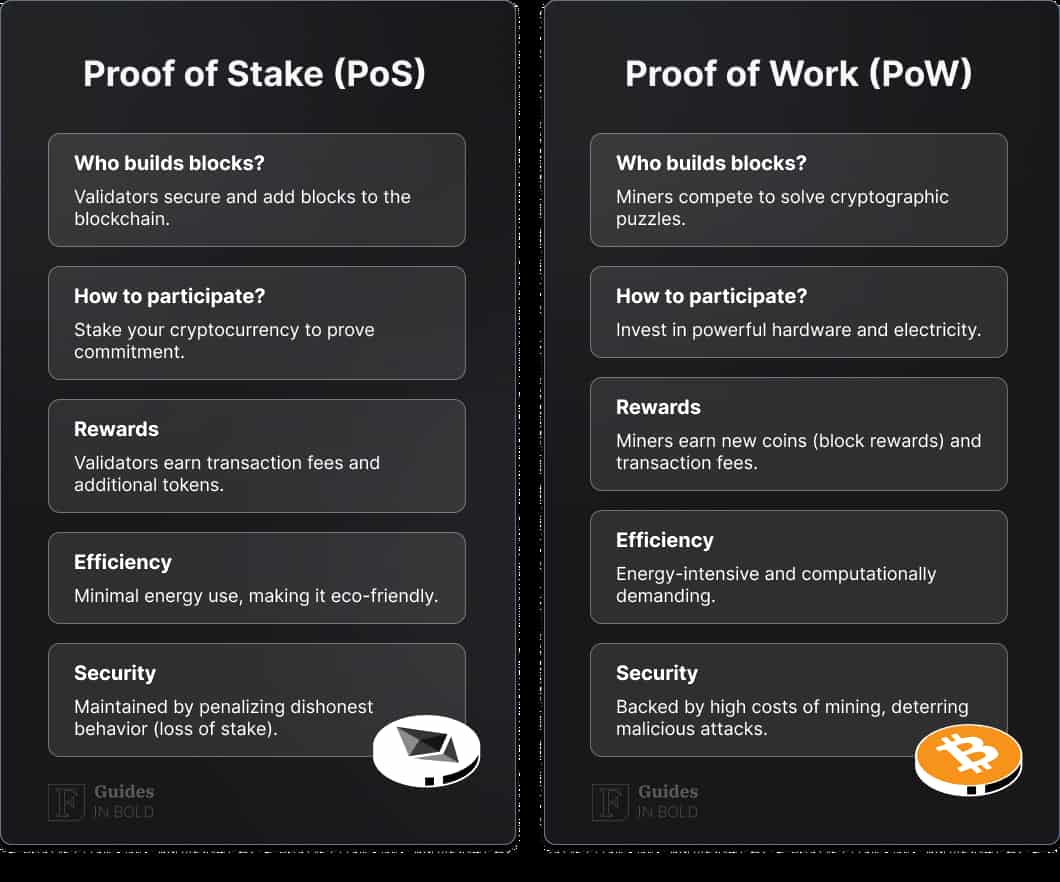IMPORTANT NOTICE
Finbold may provide educational material to inform its users about crypto and digital assets. This content is for general information only and does not constitute professional advice or training certification. Content is provided "as is" without any warranties. Users must conduct their own independent research, seek professional advice before making investment decisions, and remain solely responsible for their actions and decisions.
RISK WARNING: Cryptocurrencies are high-risk investments and you should not expect to be protected if something goes wrong. Don’t invest unless you’re prepared to lose all the money you invest.
By accessing this Site, you acknowledge that you understand these risks and that Finbold bears no responsibility for any losses, damages, or consequences resulting from your use of the Site or reliance on its content. Click here to learn more.
This article will focus on the Proof of Stake (PoS) consensus mechanism and how blockchain investors can profit from cryptocurrency staking. In the coming sections, we will define and highlight the various staking models, some coins utilizing staking together with their returns on investment (ROI), and some leading staking-as-a-service providers.
Best Crypto Exchange for Intermediate Traders and Investors
-
Invest in cryptocurrencies and 3,000+ other assets including stocks and precious metals.
-
0% commission on stocks - buy in bulk or just a fraction from as little as $10. Other fees apply. For more information, visit etoro.com/trading/fees.
-
Copy top-performing traders in real time, automatically.
-
eToro USA is registered with FINRA for securities trading.
Introduction
When Bitcoin (BTC) launched back in 2009, it introduced the distributed ledger concept known as the blockchain. The distributed ledger was the missing ingredient that would make digital currencies a reality.
The idea behind the distributed ledger is to have copies of the blockchain held by multiple computers (called nodes) in different locations. It’s a system in which a simple majority of the nodes get to vote on what goes into the ledger. Whenever there is a conflict between copies of the ledger, the version held by the majority of the nodes becomes the ‘true’ version.
In essence, the nodes have to get into an agreement or a consensus of the true version of the ledger.
The process through which the consensus is reached varies between various projects and networks. For instance, Bitcoin (BTC) and Ethereum (ETH) use Proof-of-Work (PoW) consensus, while EOS and Cardano (ADA) use the Proof of Stake (PoS). In this definitive guide on cryptocurrency staking, we’ll focus on the latter consensus.

What is cryptocurrency staking?
In some ways, this is similar to how a traditional company works. Shareholders have stakes within a company, which gives them the right to vote in the management and directorship of a company. Staking rewards can vary from 5% to 30% APR depending on which coin is being staked.
Cryptocurrency staking is a way to incentivize good behavior within the blockchain network. If a staker acts in a way that is contrary to community policies, they risk losing their staked assets.
Staking can be done through various methods – individually, within a pool, or using a delegate. The staking policies of each network determine the efficacy of any of these staking methods. As we will discuss later in this article, there are various models of staking, and some are similar to the three methods outlined here, while others allow for the use of more than one or all the staking methods.

Proof-of-Stake vs. Proof-of-Work
In the introductory section above, we mentioned that Bitcoin uses a Proof of Work (PoW) consensus mechanism. Ethereum, the second-largest blockchain network after Bitcoin in terms of market capitalization, currently uses PoW. However, Ethereum’s core developers are currently working on a core upgrade that will see Ethereum migrate from PoW to Proof of Stake (PoS).
And it’s not just Ethereum. Several other projects being launched today are also shunning PoW for PoS, which begs the question – is PoS better than PoW. How do the two consensus mechanisms compare?

Security
In terms of security, the PoW networks have proven to be a mixed bag. On the one hand, major networks such as Bitcoin, Litecoin, and Ethereum are extremely secure. This is because they have amassed a substantial hash rate that it is not economically viable for a malicious party to attack these networks. The hash rate is a measure of the amount of computing power miners within the network are contributing to keeping the network secure.
Unfortunately, smaller networks using PoW are prone to the infamous 51% attacks. Ethereum Classic is one such network that was attacked thrice in August 2020. In these attacks, a malicious party accumulates at least 51% of the network’s hash rate, which means that they can control the generation of blocks.
PoS networks don’t have to worry about 51% attacks. This does not mean that they can’t happen. It only means that just like well-established PoW networks, PoS networks are almost immune to these attacks. Given that all nodes within the PoS network have to stake a minimum amount of native coins or tokens, it will be foolish to try to jeopardize the value of your investment.
Scalability
Scalability is the ability of a network to increase its capacity to handle more transactions per second. This is a particular fault for the PoW networks such as Bitcoin and Ethereum. These networks can only process five and fifteen transactions per second, respectively.
PoS, on the other hand, is much more scalable. For instance, if Ethereum finally upgrades to version 2.0, it will process as many as 10,000 transactions per second (TPS). EOS, another popular PoS network, can process close to 4,000 TPS. These figures are several-fold higher compared to their PoW counterparts.
Environmental impact
There is an ongoing debate about the environmental impact of mining PoW coins such as Bitcoin. According to the latest figures shared through the University of Cambridge’s bitcoin electricity consumption index website, Bitcoin miners are estimated to consume 27 terawatt-hours (TWh) a year.
And this is only the average estimate. The upper band of that estimate is 488 TWh. Arguably, a bulk of the energy used to mine PoW coins ends up wasted because only one of the miners is rewarded for their efforts.
Another debate related to energy consumption is that the bulk of the electricity used for mining is sourced from non-renewable resources. We are talking coal, natural gas, and nuclear energy. Environmentalists argue that the use of these limited resources leads to their depletion and contributes to global warming.
Scalability, security, and environmental impact are not the only differences between PoW and PoS blockchain networks. However, these are arguably the main selling points for staking coins. PoW also has its pros, but we will focus on PoS in this guide.
Staking models
Now that you understand a little about why staking matters beyond just profitability, let’s briefly discuss the various models of PoS networks. These models dictate how stakeholders participate within the network, and sometimes, it affects profitability.
1. Pure Proof of Stake (PoS)
A plain or pure PoS network allows stakeholders to directly verify transactions and partake in the network’s governance without delegating responsibilities. In this model, the number of coins a stakeholder has gone towards determining their likelihood of being selected to create the next block. Coins utilizing a pure PoS consensus mechanism include Algorand (ALGO) and Ethereum 2.0.
2. Delegated Proof of Stake (dPoS)
This is a cryptocurrency staking model in which the network stakeholders vote for a delegation of stakeholders responsible for transaction verification, block generation, and network governance. This model is utilized in several PoS networks, including EOS, Tron (TRX), and Icon (ICX).
3. Masternodes
As the name alludes, Masternode is a blockchain server with more functionality compared to the normal nodes that only hold the full copy of the network ledger. It can be designed to offer additional functionality such as anonymizing transactions for privacy-oriented coins, partaking in governance tasks, and verifying transactions. The stakeholders maintain Masternodes. PoS coins utilizing masternodes include Dash, PIVX, SysCoin (SYS), and Energi (NRG).
4. Federated Byzantine Agreement
In this staking model, pioneered by Ripple then later adopted by Stellar, there is no reward to create and run a node. At least not from the network itself. In the Stellar implementation, node creators and maintainers are actual firms and individuals that require a cross-border payment solution. The incentive is to have a functional network through which to process your transactions. Once a party has created a node and invested in the infrastructure to run the node, they effectively have a stake in the network.
To achieve a consensus, each node uses a trusted set of nodes called quorum slices, pre-approved by each participating node, more like having a trusted set of friends who, together with you, verify the transactions processed through the node-set.
5. Dual token model
Most notably used by NEO network – the “Chinese Ethereum” network. NEO was nicknamed after Ethereum due to similarity in functionality. However, while Ethereum currently uses the PoW consensus mechanism, NEO uses the delegated Byzantine Fault Tolerance (dBFT) model to achieve consensus.
NEO uses a staking model to incentivize governance participation. Two tokens are used within the NEO network. NEO, which is the native token for value transfer and GAS for payment of transaction fees. NEO stakeholders are also responsible for voting for their governance council – a 21 member council.
For every successful block created on the NEO blockchain, 5 GAS tokens are rewarded and split amongst the council members, NEO token holders, and the network voters.
Cryptocurrency staking requirements
Staking requirements vary from network to network as various networks demand different levels of participation from their stakeholders. However, the two most common requirements to start staking in most networks are capital and technical know-how.
Capital
Most PoS networks demand a minimum investment from their stakeholders who wish to verify transactions, in governance, or both. This is a normal requirement, but not all coins have this as mandatory. Some networks such as Cardano have no minimum entry balance to qualify as a validator.
A majority, however, make it mandatory to hold a minimum balance of the native token. For instance, Ethereum requires stakers to hold at least 32 ETH coins to become validators.
Some networks require massive investments to join validator ranks. Dash, for instance, requires a minimum of 1,000 DASH coins to run a masternode. At current market rates, this represents a $330,000 investment.
Beyond your minimum token balances, there are other costs involved depending on your staking setup. A more hands-on approach whereby you are staking solo will require a more significant investment than joining a staking pool or using a staking services provider. You could also opt to invest in complementary hardware such as hardware wallets (e.g., Ledger wallets) which will cost you extra to get setup.
Your total staking startup capital will vary depending on the network, your staking setup (whether solo or pooling resources), and your goals.
Technical considerations
The technical bit of staking might be a tall order for most beginners. Perhaps that is why staking-as-a-service (SaaS) providers are becoming more popular. We will be highlighting some of the most popular SaaS providers later in this article. These services help offload the stakeholder’s burden of having to deal with the technical requirements.
You are probably aware of how mining pools work. Investors buy and set up a mining rig then connect it to a mining pool to which they contribute the miner’s hash rate. This increases the chances of the mining pool creating a block.
With staking networks, the upfront costs may be a little less expensive than investing in a mining rig. The only requirement that the stakeholder has to fulfill is purchasing the minimum stake requirement. They can then hold those coins in storage infrastructures offered by the SaaS provider.
This could be an online crypto wallet offered by crypto exchanges such as Binance or a cold-storage vault offered by custody services providers such as Coinbase Custody. This way, the SaaS provider will then add these coins to a larger pool of staked coins from other stakeholders.
Some of the stakeholder responsibilities within PoS networks that require them to have technical know-how include:
- Participating in governance through voting;
- Verifying transactions;
- Developing network standards;
- Ensuring maximum uptime of self-hosted node infrastructure such as masternodes;
- Participating in forum discussions and generally be active in the community;
- In networks such as Stellar that use the FBA consensus mechanism (one of the staking models), nodes have the burden of choosing which trustworthy nodes with which to work and include within their quorum slices.
Staking can be as simple as buying tokens and holding them in a wallet. But, depending on your level of commitment and hands-on approach, it can be very complex.
Best Crypto Exchange for Intermediate Traders and Investors
-
Invest in cryptocurrencies and 3,000+ other assets including stocks and precious metals.
-
0% commission on stocks - buy in bulk or just a fraction from as little as $10. Other fees apply. For more information, visit etoro.com/trading/fees.
-
Copy top-performing traders in real time, automatically.
-
eToro USA is registered with FINRA for securities trading.
Cryptocurrency staking risks and costs
A good investment will have some risks, and as a potential investor, you need to evaluate them to make a more informed decision. Investing in blockchain is no different. Staking, in particular, comes with a lot of risks, but the upside can be high enough to offset the cost and risks of investing.
1. Liquidity risks
Most staking networks require that staked coins remain in ‘bondage’ for a specified amount of time, and within this period, they cannot be moved. If an investor fails to abide by this restriction, they risk losing any unclaimed rewards.
2. Price and interest fluctuations
Cryptocurrencies are highly volatile assets. Given that most staking networks have un-bonding restrictions preventing stakeholders from moving their assets, there is a risk of loss if the locked asset falls in value while in bondage.
Interest rates also fluctuate frequently. Interest rates are the reward ratios for staking coins, and most blockchains utilize a variable factor when calculating the interest rate. For instance, the more stakeholders competing for rewards, the lower the interest rate and vice versa.
3. Security risks
There are several ways to stake. You could use a custodial or a self-custody wallet. If you opt to use a SaaS provider such as an exchange, most require that you hold your assets within the exchange wallet. Crypto exchange platforms are not the safest places to store your coins, especially over long periods.
4. Opportunity costs
Not exactly a risk, but the opportunity cost is a big factor when choosing which coin to stake. Opportunity cost is the price you pay for investing in one coin over another. Different coins have different returns, inflation rates, and liquidity restrictions. Choosing one coin over another may mean that you will be forfeiting any potential perks to investing in the other coin. This could be higher returns or staking flexibility.
You may also have to incur an opportunity cost by choosing one staking provider over another. These services offer varying features, and one provider may have more flexibility with customer assets over another. For instance, some allow their customers to use staked assets as security for loans. These are some of the perks you will have to forego by choosing one platform over another.
5. Operational risks
This is an important factor to consider, especially for more active stakeholders such as those running masternodes. Operational risks could be infrastructure failure that may cause your node to go offline. A SaaS provider could also suffer a functional failure that could cause them to go offline.
Depending on which network you have staked in, you may miss out on rewards, or worse, you may lose unclaimed rewards. You could also miss out on governance activities during the moment your node was offline.
Best Proof-of-Stake coins to stake
What are the best staking coins to invest in right now? There is quite a number, but below we have selected just five of the best PoS networks to get your list started. These are notable coins in terms of yearly returns (ROI), vibrant communities with support from several SaaS (staking-as-a-service) providers, or just overall solid market presence in terms of valuations and age. The list is not arranged in any particular order, and as always, DYOR (do your own research) before investing in any asset.
1. Cardano (ADA)
Founded by one of Ethereum’s creators, Charles Hoskinson, Cardano is a smart contract platform similar to Ethereum. Unlike Ethereum, though, it has implemented a PoS consensus mechanism from the very beginning. The project was launched in 2017 through a token crowd sale (ICO) that ran between September 2015 and January 2017, raising about $63 million.
2. Tezos (XTZ)
Another smart contract platform, Tezos, was created by a husband and wife tag team – Arthur and Kathleen Breitman. After four years of active development through the Dynamic Ledger Solutions company, Tezos finally launched its main net in 2018.
Tezos market adoption has exploded with support from cryptocurrency staking platforms such as Binance, Coinbase, and Kraken. Transaction verification, governance participation, and maintaining security are done through a process called ‘baking.’ Baking is similar to mining for PoW networks such as Bitcoin.
3. Polkadot (DOT)
Polkadot is a cross-chain solution designed to enable interoperability between various blockchain networks. The network is a recent entrant into the market, having launched in May 2020.
DOT is the brainchild of another Ethereum co-creator Gavin Wood. Wood partnered with Robert Habermeier and Peter Czaban to launch the Web3 Foundation, the entity behind Polkadot.
The network uses a delegated PoS consensus mechanism whereby stakeholders nominate between 1 and 16 validators. Not all stakeholders are required to participate in the nominations. Rewards earned by the validators are shared with their nominators.
4. Algorand (ALGO)
Algorand is a decentralized applications (dApp) platform launched in June 2019 by MIT Computer Science professor Silvio Micali. The blockchain aims to solve the tripartite problem that current blockchains face – decentralization, security, and scalability. The network employs a permissionless pure PoS consensus mechanism.
Since its launch in 2019, Algorand has seen developers in various industries create dApps on the platforms. The dApps are in sectors including real estate, decentralized finance (DeFi), microfinance, and copyright.
Participating in governance and transaction verification is direct and straightforward. You can opt to run a participation node or use one of the several staking services that run participation nodes such as Binance Staking, StakeFish, Figment, or Cypher Core.
5. Ethereum (ETH)
Ethereum is the second-largest blockchain network by market cap after Bitcoin. Launched in July 2015 by a team of developers led by Vitalik Buterin, Ethereum is arguably the largest smart contract platform in the market.
Ethereum was launched as a Proof of Work (PoW) and still runs under the PoW consensus mechanism. However, the network’s core developers have been working on an upgrade to migrate the network to the staking (PoS) mechanism.
The upgrade is scheduled to occur in phases, with the first phase (Phase 0), dubbed Beacon Chain went live on December 1st, 2020. This means that staking and rewards are already activated on the network.
Tip
These are just some of the leading networks that support staking. The blockchain space is constantly changing, and so does the staking rewards. Other coins in the market may offer higher returns than those featured above.
Visit StakingRewards for a rundown of the coins and tokens you can stake and their returns.
Where to stake crypto? Top 6 staking providers
Staking can be complicated and too technical for the everyday investor. That is where staking services come in. They take care of the technical part of staking. Functions include setting up and maintaining masternodes in Dash or PIVX, participation nodes in Algorand, or vetting nodes to include in quorum nodes for Stellar.
It can easily overwhelm even individual stakers with a technical inclination.
Another benefit that Staking providers bring to the table is lowering entry requirements. We’ve highlighted in a prior section that there often is a minimum investment to becoming a validator within a network. However, staking providers don’t have such requirements.
However, staking providers are different. They differ in several aspects, including the number of assets they support, their fees, and complimentary services offered, such as loan products.
This section looks at some of the more popular and established staking services providers and how they compared against each other. We feature three exchanges and two standalone staking providers.
1. Binance staking

Binance is the leading cryptocurrency exchange by daily traded volume. It offers lots of products, including spot, margin, OTC, and P2P trading, investing in blockchain startups, buying and selling crypto, DeFi services such as loans and savings, crypto derivatives.
Anyone can participate in staking cryptocurrency on the platform through flexible packages. There is locked staking, whereby assets are locked for a specified amount of time, and flexible staking, whereby assets are not locked. The former offers higher interest rates than the latter and typically lasts between 15 and 90 days of lock periods.
2. Coinbase

Another major publicly traded cryptocurrency exchange based in the United States, Coinbase, has been in the blockchain space since 2012 making it one of the oldest exchanges. It is highly regulated in the US, the UK, and across the EU economic zone. It is one of the few exchanges to receive the highly coveted BitLicence from the New York Department of Financial Services (NYDFS).
The exchange provides services such as buying and selling crypto, trading, staking, and custody services.
3. Kraken

San Francisco-based Kraken exchange was launched in 2011 and is one of the leading and most trusted exchanges in the market today. It offers services including buying and selling crypto, trading, and staking.
The returns are decent, with the fees being competitive to other staking providers.
4. MyContainer

MyCointainer is an Estonian-based staking provider with an in-built cryptocurrency fiat-onramp and exchange. Launched in 2018, the company has grown to become one of the most notable SaaS companies just a few years later.
Investors can use the service to invest in a broad range of assets, buy and sell their assets for profit, stake various PoS coins, and delegate management for some staking networks that utilize masternode infrastructure. It is a highly versatile service provider with very competitive returns.
Unlike most SaaS providers, MyCointainer uses a dual subscription model for its users. A free subscription and paid plans for premium members (referred to as Power users). The premium subscription plans cost between 7.90 EUR and 29.90 EUR per month, and they come with several benefits such as 0% staking fees, VIP discounts, airdrops, giveaways, and offers.
5. Staked.Us

Staked is one of the more popular and largest staking services in the market, with over $2B worth of staked tokens and coins under management. According to Stakingrewards, Staked has around 10,000 active stakeholders participating in various blockchain networks.
The staking service is based in New York, US. It was initially launched as a solution for institutional investors seeking to participate in the blockchain market.
Unlike MyCointainer, Staked does not offer direct purchases or exchanges of assets within its platform. Any supported assets have to be deposited from an external wallet to be held for staking.
Staked also offers lending services.
Staking Pros and Cons
These are some of the advantages and disadvantages of staking coins. They include:

Pros
- Lower entry requirements than mining;
- More energy efficient compared to mining;
- Excellent passive income venture;
- More flexible between staking different coins than mining;
- Generally, higher returns compared to mining coins.

Cons
- Highly technical, forcing most non-technical investors to opt for staking services;
- PoS as a consensus mechanism is not as prevalent and battle-tested as PoW networks such as Bitcoin;
- Staking networks are more prone to centralization and network hijacking from deep-pocketed investors;
- Opportunity costs are incredibly high;
- High risks of making losses due to the high volatility of the crypto market.
Cryptocurrency staking: Conclusions
Staking is an excellent way for investors to take part in governing nascent blockchain networks and be rewarded handsomely for their contributions. We hope that you are now more informed about staking.
In this guide, we have discussed some of the most critical aspects of staking, including what it is, how it compares to mining, some of the popular staking models, the risks inherent in staking your coins, and the costs.
We also looked at some of the best networks that utilize the PoS staking mechanism for consensus with relatively competitive rewards. For the less technically-minded, we highlighted some ways to participate in staking using intermediaries, aka staking services, or SaaS (staking-as-a-service) providers. This could be done through exchanges such as Binance or fully-fledged staking services such as US-based Staked.Us.
Finally, we have highlighted the pros and cons of staking. Like most investment ventures, staking has its merits and demerits, which an astute investor should consider before investing.
Disclaimer: The content on this site should not be considered investment advice. Investing is speculative. When investing, your capital is at risk.
Cryptocurrency staking | FAQs
What is cryptocurrency staking?
Cryptocurrency staking is the process of locking up a portion of your assets to qualify to earn staking rewards (interest), participate in the governance, and verify the transactions within a certain decentralized network. In some ways, this is similar to how a traditional company works. Shareholders have stakes within a company, which gives them the right to vote in the management and directorship of a company. Staking rewards can vary from 5% to 30% APR depending on which coin is being staked.
Is staking cryptocurrency profitable?
Staking cryptocurrency can be profitable. This depends on several factors, including the choice of network, whether they are staking through a staking service, and the price action of the specific coin. Additionally, the duties carried out by the stakeholder could also determine the amount of reward they receive. Validators usually receive higher rewards compared to offline or inactive stakeholders.
Can I stake cryptocurrencies on the Binance exchange?
Yes, you can. Binance is a leading crypto exchange platform offering a variety of crypto-related services, including staking. The platform allows investors to stake more than 50 cryptocurrency assets with returns varying between 4% and 40%.
What are the risks of cryptocurrency staking?
There are several risks involved in crypto staking. The nature of having to lock your assets in a given location over extended periods exposes your assets to several potential unintended outcomes. These include:
- Security risks – coins/tokens are often held in a hot wallet, and these are not the safest storage solutions.
- Price risks – crypto coins are highly volatile assets, and between the time you stake your coins and when you can withdraw them, there is a chance that they may have lost their value. This risk is propagated by the restriction by some staking networks against moving or unstaking assets between staking terms.
- Operational risks – there is a chance that the infrastructure used for staking, such as nodes hosted on cloud hosting services, could go offline, leading to operational inefficiencies or, worse, losing staking rewards.
Is staking crypto worth it?
Yes, staking crypto can be worth it if you aim to earn passive income and hold assets long-term. However, it involves risks such as market volatility, lock-up periods, and potential loss of staked assets if the network is compromised. Always assess the project and staking terms before committing in any funds.
Is staking crypto safe?
Staking crypto is generally considered safe if done on reputable platforms and secure networks. However, it carries risks like market volatility, penalties for validator misconduct, and potential platform vulnerabilities.





